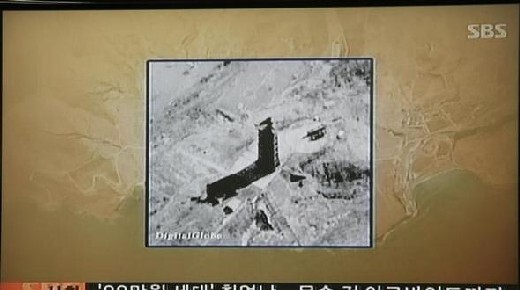hankyoreh
Links to other country sites 다른 나라 사이트 링크
‘Satellite’ launch fuels speculation about North’s military technology

There is growing interest in the state of North Korean military technology, particularly whether it has the capability to successfully launch a satellite, now that Pyongyang is making launch preparations.
North Korea test-fired a Rodong-1 missile with a 1,000 kilometer range in May 1993. Five years later, in August 1998, it fired a Taepodong-1 missile with double the range of the Rodong-1. The first stage fell into the East Sea, the second passed through Japanese airspace at an elevation of 65 kilometers, and the third stage is believed to have burned up after failing to find its target path. It launched a Taepodong-2 missile in July 2006 that maintained normal flight for approximately 40 seconds before it is believed to have fallen into the East Sea.
The North is believed to have made technological progress since that time. Experts believe it at least has the ability to launch a low-orbit satellite in the head of the Taepodong-2, which is known in the North as the Unha-2. One South Korean government official said it is believed the Taepodong-2 is the result of development of the fuel, navigational and warhead separation technology of the Taepodong-1. It has also been learned that the North has spent considerable effort on the development of solid fuel, making it likely that some solid fuel might go into the Taepodong-2. Recently developed missiles have been using solid fuel, which is easier to transport and faster to load than liquid fuel.
Even if the North launches a satellite with technology it has developed on its own, “if it doesn’t have the know-how to control the satellite once in orbit there’s no use in launching one,” said an official at the Korea Astronomy and Space Science Institute. It is unlikely the North has the technology to find its own unique orbit, one that does not overlap with other existing satellites.
The U.S. Office of the Director of National Intelligence said in December 2006 that North Korea had imported some materials and parts to make warhead missile, but that otherwise it was self sufficient in that regard. Many experts continue to believe, however, that there must be limits to how far North Korea’s independent knowledge really extends, whether it has the ability to produce satellite parts that can withstand temperature extremes and zero gravity.
Please direct questions or comments to [englishhani@hani.co.kr]
Editorial・opinion
![[Column] Park Geun-hye déjà vu in Yoon Suk-yeol [Column] Park Geun-hye déjà vu in Yoon Suk-yeol](https://flexible.img.hani.co.kr/flexible/normal/500/300/imgdb/original/2024/0424/651713945113788.jpg) [Column] Park Geun-hye déjà vu in Yoon Suk-yeol
[Column] Park Geun-hye déjà vu in Yoon Suk-yeol![[Editorial] New weight of N. Korea’s nuclear threats makes dialogue all the more urgent [Editorial] New weight of N. Korea’s nuclear threats makes dialogue all the more urgent](https://flexible.img.hani.co.kr/flexible/normal/500/300/imgdb/original/2024/0424/7317139454662664.jpg) [Editorial] New weight of N. Korea’s nuclear threats makes dialogue all the more urgent
[Editorial] New weight of N. Korea’s nuclear threats makes dialogue all the more urgent- [Guest essay] The real reason Korea’s new right wants to dub Rhee a founding father
- [Column] ‘Choson’: Is it time we start referring to N. Korea in its own terms?
- [Editorial] Japan’s rewriting of history with Korea has gone too far
- [Column] The president’s questionable capacity for dialogue
- [Column] Are chaebol firms just pizza pies for families to divvy up as they please?
- [Column] Has Korea, too, crossed the Rubicon on China?
- [Correspondent’s column] In Japan’s alliance with US, echoes of its past alliances with UK
- [Editorial] Does Yoon think the Korean public is wrong?
Most viewed articles
- 1[Column] Park Geun-hye déjà vu in Yoon Suk-yeol
- 2Will NewJeans end up collateral damage in internal feud at K-pop juggernaut Hybe?
- 3Thursday to mark start of resignations by senior doctors amid standoff with government
- 4Why Korea shouldn’t welcome Japan’s newly beefed up defense cooperation with US
- 5‘We must say no’: Seoul defense chief on Korean, USFK involvement in hypothetical Taiwan crisis
- 6[Guest essay] The real reason Korea’s new right wants to dub Rhee a founding father
- 7N. Korean hackers breached 10 defense contractors in South for months, police say
- 8[Column] ‘Choson’: Is it time we start referring to N. Korea in its own terms?
- 9[Editorial] New weight of N. Korea’s nuclear threats makes dialogue all the more urgent
- 10Kim Jong-un expressed ‘satisfaction’ with nuclear counterstrike drill directed at South